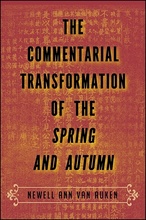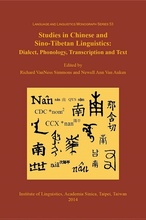Newell Ann Van Auken, Ph.D.
I teach Classical Chinese literature, a major world literary tradition spanning over thirty centuries, deeply influential throughout East Asia, extending into contemporary times and resonating across the globe. My research focuses on early China, and I am also a translator. I am fascinated by the gap between the earliest readings of texts and their later interpretations, including those of my students today. I believe that all interpretations (even “misunderstandings”) can give us valuable insight into those who generated them and the lens through which they view the world.
Teaching
My teaching focuses on the literature and texts of premodern China and East Asia, and all of my courses include a creative component, such as a writing a creative adaptation of a literary work or a translation. In my courses, my students engage deeply with the literary works and are transformed from readers and observers to active participants in reinterpreting the ancient literary tradition and bringing it across into our contemporary world.
Courses taught:
- WLLC/ASIA/TRNS:3208 – Classical Chinese Literature through Translation
- WLLC/TRNS:2473 – Cinderella
- WLLC/ASIA/GWSS:2222 – Women in Premodern East Asian Literature
- WLLC/ASIA:1510 – Ghosts & Tales of the Weird in Premodern Chinese Literature
- WLLC:1000 – First-Year Seminar: Cinderella International!
- WLLC/ASIA:1016 – Classical Chinese Short Fiction
- CHIN:4101;4102 – Classical Chinese: First & Second Semester
Research interests
My research focuses on pre-imperial China, before the second century BCE. The study of ancient China is inevitably interdisciplinary, and my work incorporates textual and literary studies, history, commentary studies, and translation, and also draws on religious studies, archaeology, and gender studies.
My most recent book, Spring and Autumn Historiography: Form and Hierarchy in Ancient Chinese Annals (Columbia, 2023), concerns one of the earliest historical records transmitted from ancient China down to today, called the Spring and Autumn (Chūnqiū 春秋). My main concern is not history—what happened?—but historiography—what interpretation did the record-keepers impose onto the events they recorded, and what do the records tell us about their priorities, and how they viewed themselves and others?
In The Commentarial Transformation of the Spring and Autumn (SUNY, 2016), I address a question that has puzzled scholars for centuries: how did the ostensibly objective Spring and Autumn records come to be understood as conveying the judgments of Confucius? I explores two sets of commentaries that are embedded in the Zuǒ Tradition, and shows how early interpretations of the Spring and Autumn provide the missing link between ancient historiographical practices and the later orthodox interpretation.
I have a secondary interest in Chinese linguistics, and together with Richard VanNess Simmons (Rutgers/HKU) I co-edited Studies in Chinese and Sino-Tibetan Linguistics: Dialect, Phonology, Transcription and Text (Academia Sinica, Institute of Linguistics, 2014).
Selected publications:
Books:
- 2023, Spring and Autumn Historiography: Form and Hierarchy in Ancient Chinese Annals (Columbia, 2023)
- 2016, The Commentarial Transformation of the Spring and Autumn (SUNY, 2016)
- 2014, Studies in Chinese and Sino-Tibetan Linguistics: Dialect, Phonology, Transcription and Text 漢語與漢藏語研究:方言、音韻與文獻, with Richard VanNess Simmons (Institute of Linguistics, Academia Sinica, 2014)



Articles & Chapters:
- 2022, Women as a category and categories of women: Gender and hierarchy in the Chunqiu. NAN NÜ: Men, Women and Gender in China 24.1:1–69.
- 2019, What if Zhào Dùn had fled? Border crossing and flight into exile in early China, JAOS 139.3: 569–590.
- 2016, Judgments of the Gentleman: A new analysis of the place of junzi comments in Zuozhuan composition history, Monumenta Serica 64.2: 277–302.
- 2014, Killings and assassinations in the Spring and Autumn as records of judgments, Asia Major 27.1: 1–31.
- 2014, Spring and Autumn use of jí 及 and its interpretation in the Gōngyáng and Gǔliáng commentaries. In Simmons & Van Auken, Studies in Chinese and Sino-Tibetan Linguistics.
- 2012, Who is a rén 人? The use of rén in Spring and Autumn records and its interpretation in the Zuǒ, Gōngyáng and Gǔliáng commentaries. JAOS 131.4: 555–590.
- 2010, Could “subtle words” have conveyed “praise and blame”? The implications of formal regularity and variation in Spring and Autumn (Chūn qiū) records. Early China 31(2007): 47–111.
- 2004, The modal negative wu in Classical Chinese. In Meaning and Form: Essays in Pre-modern Chinese Grammar and Semantics, ed. Ken’ichi Takashima and Jiang Shaoyu (Lincom Europe), 91–210.
- 2002, The etymonic determinatives of wanq (望, 朢). JAOS 122.3: 520–533.
